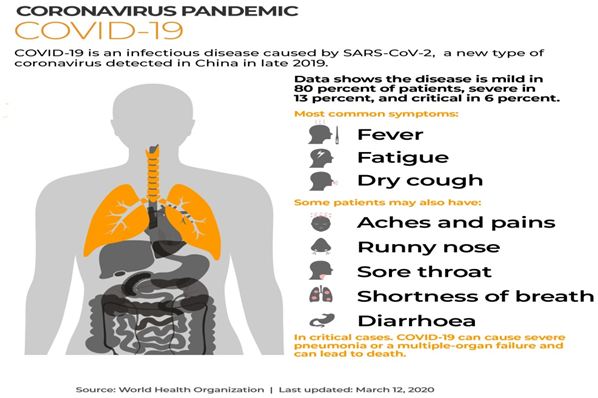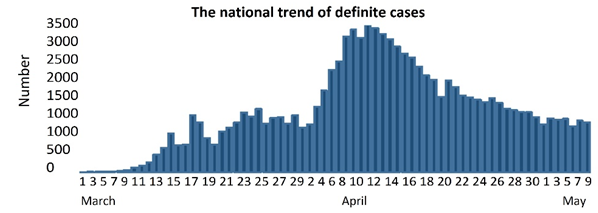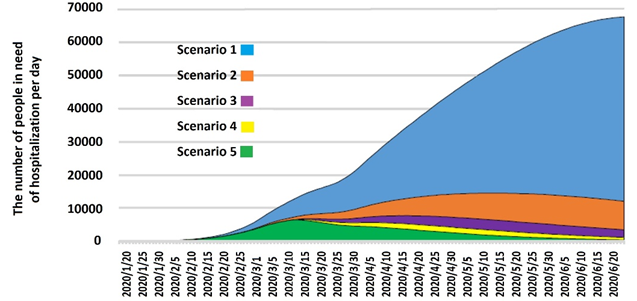Journal of
eISSN: 2373-6453


Mini Review Volume 8 Issue 4
1Department of Microbiology, Islamic Azad University, Iran
2Nursing student of Islamic Azad University, Iran
Correspondence: Houshang Jamali, Department of Microbiology, Islamic Azad University, Jahrom Branch, Jahrom, Fars, Iran
Received: July 06, 2020 | Published: October 30, 2020
Citation: Jamali H, Jafari MR. The epidemiology of Coronavirus SARS Cov-2 virus in Iran. J Hum Virol Retrovirolog. 2020;8(4):120-123. DOI: 10.15406/jhvrv.2020.08.00231
Background and objectives: SARS Cov-2 the enveloped, non-segmented, positive sense RNA virus has changed the biological life of the planet Earth in a short time. Since COVID-19 is now considered a pandemic disease and COVID-19 is now spread in all regions of this country, the goal of present study was to observe the spread of the disease in Iran and the problems in treating the disease.
Methods: First, the virus and its history was reviewd, and then the epidemic of this disease from the initial stages to present time (1/18/98) was examined and the problems were expressed, then solutions were proposed.
Conclusion: In order to protect the people and their resources (the same people and equipment), the chain of infection should be cut off and the rate of infection should be reduced so that the treatment system can respond to patients. A method to prevent the spread of SARS Cov-2 is to quarantine cities and areas infected with the virus. Quarantine should be started before the initiation of symptoms.
Keywords: new coronavirus, epidemic, SARS Cov-2, quarantine, and transmission routes
SARS Cov-2 the enveloped, non-segmented, positive sense RNA virus has changed the biological life of the planet Earth in a short time. ACE2 levels in men are higher than in women. Asians have higher levels of ACE2 than whites and African Americans. New coronavirus binding increases ACE2 expression, which can lead to damage to alveolar cells. Injury to alveolar cells can in turn cause a series of systemic reactions and even death. As a result, Asian men are more likely to be infected with the new coronavirus infection.1 In 2002, SARS was diagnosed in southern China, with 80,988 infected and 774 deaths across the country between November 2002 and January 20033 and again in 2012, in Saudi Arabia, a disease called Mers, which lasted from September 2012 to September 2012. In September 2016, 1806 people were infected and 643 were killed,4 which had a mortality rate of 9.55 and 36.7 percent, respectively (Figure 1).3,4

Figure 1 3D image of the virus Source: Queens University.5
The most prominent feature of these viruses is that they have superficial spawning surfaces and 4 different families have been discovered, including alpha, beta, gamma, delta, which is the cause of Mort's disease in the beta family.5,6 From the genetic dimension of sars-cov-2, about 80% is similar to sars-cov7 and 96% are similar to bat-like corona and are approximately 99.8% close to the sars-cov-like intermediate sample. The difference in the genome of the two includes 202 single nucleotides.8,9 There is no logical reason to claim the new Kurdish corona is directly related to the bat corona, but there is evidence to suggest that this is a natural process in the evolution of the virus.9 Because the relationship between humans and bats is small, it is also necessary to find a closer animal corona.10 Since the SARS epidemic, the association of the sars cov with bats has been discussed.11 The relationship between humans and bats is small. In 2015, a report was published in the Chinese media claiming the addition of the s-co-14 gene to sars-cov could infect humans in addition to mice, but no scientific source supported the report,8,12–14 but Corona virus with the help of an RNA genome has a high potential for mutation and transmission to humans.15 However, there is speculation that the sars-cov-2 virus is of laboratory origin and was released from a laboratory in Wuhan, China. However, this idea needs further study.9 Given China's limitations on information, it seems unlikely that further evidence will be obtained. Dr. Lee van Hong, an ophthalmologist from Wuhan, was the first to warn about the signs of the new coronavirus virus on December 30, 2019. He first reported seven cases of SARS-like disease in the Huana seafood market, along with CTscan examinations and images.16,17 The World Health Organization has compared China's bureaucratic approach to the SARS epidemic. In an interview with The Independent, Dr. Johnson de Quick, an assistant professor of global health at Duke World Health Institute and author of The End of the Infectious Diseases, said: We have seen a different situation.18 However, the virus has spread and its transmission is possible through respiratory secretions and contact between people, and it is recommended that all people use a mask that varies according to the individual's condition. For normal people, a disposable medical mask for caregivers. Patients, staff, and long-term occupants should use a surgical mask or N95 mask.19 Also at the University of Nebraska Medical Center, 13 patients with covid-19 whose disease was diagnosed by PCR, were identified. During the hospital stay, air and various surfaces were sampled in the rooms, sampling was performed from different levels, including the usual equipment in the room, personal belongings of patients and toilets, as well as the air in the rooms and corridors. These patients had a mild degree of illness. Examples of PCR-level surfaces and aerosols were tested positive for patients' personal surfaces at 76.5%, indoor equipment levels at 80.4%, and bathroom surfaces at 81%. Room and corridor air samples provide information on viral inhalation in these areas. Room air samples at 63.2% and corridor air samples at 66.7% were positive. Recent findings indicate that the disease is also transmitted through respiratory secretions. It can be transmitted through the air, so it is important to use a mask (Figure 2).20

Figure 2 Symptoms of Quaid-19 disease Producer: Al Jazeera based on WHO report (22) Corona epidemic in Iran.
On February 20, 2017, we witnessed the first official confirmation of Coronavirus in Iran, which was related to the suspicious death of two people in Qom.23 After the experiment, it was determined that Coronavirus was a new virus and the president of Qom University of Medical Sciences said on the same day. : In the past few days, we have witnessed an increase in respiratory diseases in Qom and two deaths due to respiratory problems.24 It was announced on March 8, 2017 that almost all provinces have been affected by corona.25 In contrary to the action of all countries involved with Corona, failed in quarantining different regions of Iran19 for example the primary hubs of outbreak and even President Hassan Rouhani said we will never have something called quarantine.26 Iraj Haririchi also said that he did not believe in quarantine and called quarantine related to before the World War, and the next day he went to quarantine with a positive Corona test.27 And it is possible that I have problems, such as the simplification of events in society.
Due to the lack of quarantine in the Corona Emergence Centers in Iran, the closure of universities and seminaries and the departure of students and scholars to their cities, as well as the failure to close transportation routes between cities, spread pollution until social interventions prevented inter-provincial traffic.28 However, according to China's experience, quarantine of cities and, of course, strict curfews have been recommended. The same distribution areas do not have pollution, and through intra-provincial trips it is possible to transmit the pollution to areas that are not polluted or less polluted. In this regard, transport drivers who are constantly moving around the country can be considered as a potential source of pollution. He considered that they should be monitored. This plan could have been effective if it had been implemented before people left for other regions, including northern Iran.
In the Corona Countermeasures Plan, in the context of the Corona Basij Plan, it should be noted that the disease divides people into three groups: healthy, sick, and carriers. Carriers are generally asymptomatic or have no mild symptoms. Sampling People We have virtually left the carrier section unrecognized,29 which can infect many people until the disease is identified, so full quarantine has been put on China's agenda so that carriers can have minimal contact with healthy people.19 The distancing plan was also implemented on April 30, 199128 at which time all the provinces have been polluted and will not be effective in practice.25 Also, the closure of religious places that are the gathering places took place on March 16, 2017.30 As a place with high population density, these centers were closed 26 days after the proof of the virus in Iran. It can be said that it is too late to reduce the working hours of the offices due to the issues related to Corona, although they are facing instability.31 But this trend also caused a lot of traffic in the city, including Arbab Raj According to the Ministry of Health, 99,970 cases and 6,340 deaths have been recorded,32 but the closeness of individuals in the offices is another factor that increases the risk. We need to keep an eye on the daily sickness chart, because increasing the number of patients means increasing the demand for services and getting closer to the saturation point of the health system, which can greatly increase the volume of casualties in countries such as Italy and the United State (Figure 3).

Figure 3 Chart of New Patients by May 29 Source: Daily Epidemiology Report No. 34.32
On 10th of May 1323 new cases were registered in one day.32 Considering the fact that many people are also carriers and without symptoms, it can be concluded that the patient's population is higher than this number.19 According to the head of the Pasteur Institute, we are able to perform 10,000 tests a day.33 the limited capacity of the health system should be considered and changed in the adopted method when we reach maximum capacity and are forced to choose between people's lives. This is what happened in Italy,34 the first announcement of corona in Iran was with two deaths,23 so it can be said that this virus entered Iran at least 3 to 14 days before that date. Deputy Health Minister Dr. Malekzadeh said: We confused it with the flu, which we should have been aware of before.35 It was gloves that, given that there is a crisis around the world, you have to deal with that For future epidemics, these items should be considered by the government and relevant organizations in advance. Finally, we address the issue of modeling, which can be a guide for future forecasting and policy making (Figure 4).

Figure 4 Chart for the various scenarios of the Quaid-19 epidemic Source: Iranian Journal of Epidemiology No. 16.36
In the first scenario, it is assumed that the government and the people will not interfere and that there will be no care, that will result in 65,000 cases per day. The second scenario assumes public intervention and 10% isolation, with 12,000 new cases per day. The third scenario is the assumption of minimum intervention and a maximum of 20% isolation which will result in 3,500 infection cases per day. The fourth scenario is the assumption of moderate intervention and ejaculation of a maximum of 30%, which includes the possibility of 1200 daily infections.
The fifth scenario assumes high and intense level intervention, which will accompany a maximum of 40% isolation level and is likely to have about 450 cases per day.36,37 Infection will be slower 1. due to the lack of patient density in hospitals, 2. The possibility of vaccine development and 3. discovery of effective treatments. Of course, the direction is not clear, but now there is no cure, we can only focus on reducing the cost of life to achieve safety. The epidemic is 63% in the cold season and 37% in the summer. On the other hand, with the resumption of the cold season, more interventions are needed, so you should try to stop the disease in the hot season, because in the cold season the slope of the chart increases. In fall simultaneous Corona and influenza outbreaks, especially if no effective drug is detected, will make things very difficult.37 Adhering to health principles, social distancing and quarantine are the only ways available until introduction of an effective vaccine or drug.
In short term, the world will face global and unprecedented health, medical, economic, social and cultural challenges after Covid-19. These serious issues can be solved by increasing public confidence and global cooperation. All countries in the world have two missions; The first is to control the spread of the virus and the second is to solve the economic crisis caused by the virus.
Future suggestions and solutions for coronavirus. Since there is no vaccine or cure for coronavirus, the only effective way to control and spread the disease is the following methods:
We would like to thank all the authors who contributed to the translation and writing of this article.
The author declares no conflicts of interests.

©2020 Jamali, et al. This is an open access article distributed under the terms of the, which permits unrestricted use, distribution, and build upon your work non-commercially.